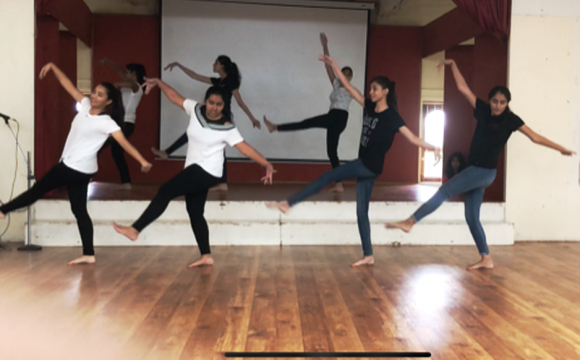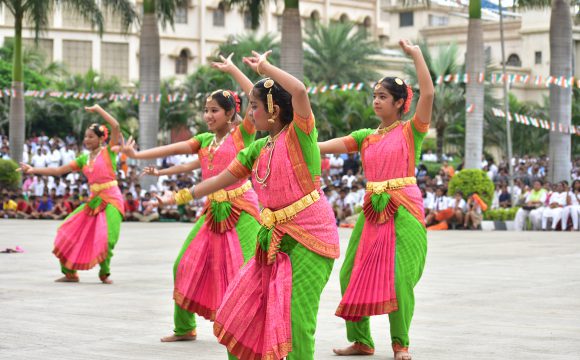
DANCE CLUB
- Clubs
Dance club
Contemporary dance style
Classical Dance – (Bharatanatyam)
Shake a leg- (Hip -Hop Dance)

- Demonstrate a knowledge and understanding of the selected dance style, through creative process, leadership, participation and reflection.
- They will develop multifaceted physicality through training in chosen dance style.
- They will learn to apply variety of dance skills and techniques in chosen dance style with systematic approach to learning aesthetics and approach to performing.
- They will learn movement vocabulary and practice methods in chosen dance style.
- The dance club will run through the year in order to ensure that students must develop the knowledge and understanding and performance skills and techniques in chosen dance style.
Club Activity: Dancing feet – for / contemporary dance planning.
The syllabus objectives are
- To gain basic to advance techniques in Contemporary Dance.
- To acquire correct posture, stance, and distribution of weight.
To develop core strength to support the correct use of stance and control of the body. - To develop the use of the body to achieve the expected alignment and shape of the body.
- To develop the ability to vary the quality and flow of movement.
- To develop the ability to move in space, using appropriate directions, pathways, and levels.
| Ser no. | Month | Activity Content | MYP 1 to MYP 3 | MYP 4 to DP 2 | Teacher in charge |
| 1 | August(4 week) | Contemporary dance
|
|
| Janhavi P. |
| 2 | September | Contemporary dance beginners |
|
| Janhavi P. |
| 3 | October | Contemporary dance |
|
| Janhavi P. |
| 4 | November | Contemporary Dance |
|
| Janhavi P. |
| 5 | December | Contemporary Dance |
|
| Janhavi P. |
| 6 | January | Contemporary Dance |
|
| Janhavi P. |
| 7 | February | Dance/Drill Technique |
|
| Janhavi P. |
| 8 | March | Performance | Apply and demonstrate a range of performance skills in Contemporary Dance | Apply and demonstrate a range of performance skills in Contemporary Dance | Janhavi P. |
| 9 | April | Performance |
|
| Janhavi P. |
- To encourage and appreciate to study of performing arts, particularly Bharatanatyam as an Indian classical dance form.

- To develop the skill by training & practical approach by using modern technology amongst the students in Bharatanatyam.
- To introduce and create a strong foundation for further perseverance of learning the subtle nuances of Bharatanatyam which will help creating a convincing performer.
- The overall approach will be flexible and open to accept new challenges and execute programmes independently, as a part of school performing arts activity.
- Students will encourage to appear for University Grade level examination for Bharatnatyam.
| Ser no. | Month | Activity Content
| MYP 1 to MYP 3 | MYP 4 to DP 2 | Teacher in charge |
| 1 | August | Introduction to Bharatanatyam Namaskaram -Information about classical dance examination. What is Adavu? Concept of Bhav Raag Taal Basic Terminology Safe Dance Practice for Bharatanatyam
| The proper way to do the Namaskaram (Namaskar) and the meaning behind that Warm-up to stretch and condition the body before all practice sessions Posture building exercises Mudras 1 to 5 Tatta Adavu Namaskar- A Bharatnatyam dancer starts and ends every session of dancing with Namaskar Dancer seeks blessings and permission from Mother Earth to stamp on her during the dance. The dancer pays respect to God (Nataraja), Teacher (Guru), and Audience.
| Proper way to do the Namaskaram (Namaskar) and the meaning behind that Warm-Up to stretch and condition the body before all practice sessions and performance Basic Adavu Movement -formations Small Abhinaya intro and movement exploration with Mudra’s
| Arti B. |
| 2 | September | Concept of Head Movements Major Limbs and Mainour limbs (Angas, Upanga and Pratyanga Concept) Basic Terminology Safe Dance Practice for Bharatanatyam | * Small composition on Lord Ganesh *Natta Adavu Movements 1 to 6
*Angashuddham – Refers to purity, clarity, and neatness of adavus. | *Adavu practice *Single Hand gesture (MUDRA) *One of the most striking features of Indian Classical Dance is the use of hand gestures. Speaking in dance via gestures, rather than orally, in order to visually convey outer events or things, as well as inner feelings, two classifications of specific traditional ‘MUDRA’ (hand/finger gesture) | Arti B. |
| 3 | October | Instrumental music and adavu exploration Understanding the rhythm and Tala Introduction to Tala System Basic Terminology Safe Dance Practice for Bharatanatyam | *Vishru Adavu 1 to 4 movements. *Tatta , Natta Adavu combination with rhythm. *Samam (Samapadam) – Feet together and standing straight. • Araimandi (Ardhamandala) – This is a basic posture of the body in Bharatnatyam in which the body should be straight, legs bent at the knee, and toes facing sideways.
| *Revision of Adavu and concept of Tala in 3 speeds. *Double hand gestures. | Arti B. |
| 4 | November | An outline knowledge of the 4 kinds of Abinaya. (Angika, Vaacika, Aaharya, Saativika) Dhyanam Slokam and its meaning Basic Terminology Safe Dance Practice for Bharatanatyam | Muzhumandi (Mandala) – The torso should be straight while sitting down on the toes of the two feet. • Sollukattu – Rhythmic syllables • Nrittahastas – Hand movements executed along with adavus solely for the aesthetic beauty of embellishment are called nritta-hastas and it’s used in movement choreography. | *(Visharu Adavu) – Ta Tai Tai Ta – importance to Swasthika position o Kudditu Mettu (Tai Hath Tai Hi – jumping on toes and striking the ground with the heels while retaining the toes-contact with the ground | Arti B.
|
| 5 | December | Shiro, Dhrushti, Greeva Bedham 1) Head 2) Eyes 3) Neck movement | Any slokas, Bajans, instrumental piece, or any other appropriate music for classical dance can be used giving importance to adavus and mudras learned so far | Nadai The basic Bharatanatyam walk involves lifting the feet while slightly lowering the body. The feet are then placed down heel first and the body is raised back up. | Arti B. |
| 6 | January | Tat Tai Tam ( Sutral Adavu) – combination of Tattu, Nattu, Swasthika and Paichaal (jump). o Paichaal Adavu – using leaps and jumps § Dhit taiyuam Tat Taa Tai | *Tai Tai tat Ta – a combination of Tattu, Nattu, and resting on toes o Sarukkal Adavu – sliding o Mandi Adavu – done in Muzhumandi position; Tham Ti tham kitathaka Tai Ta Tai | *Tai Tai tat Ta – a combination of Tattu, Nattu, and resting on toes o Sarukkal Adavu – sliding o Mandi Adavu – done in Muzhumandi position; Tham Ti tham kitathaka Tai Ta Tai | Arti Belpathak.
|
| 7 | February | Tirmana adavu – usually as an end for the sequence; Tadhing Gina Thome
Safe Dance Practice for Bharatanatyam | *; Trishram (Tha Ki Tta), Chatushram (Tha Ka Dhi mi), Khandam, (ThaKa Tha kit a), Mishram (3+4 or 4+3), Sankeernam (4+5 or 5+4) o Tadh Dhit Ta – single unit step; generally used as a connecting unit | *Review the Entire Adavus with special focus on 3rd speed. * | Arti B. |
| 8 | March | Expressions Safe Dance Practice for Bharatanatyam | *This includes an understanding and the BASIC ability to do the Navarasas. 1. Sringaram – Love,Delight 2. Hasyam – Laughter 3. Karuna – Compassion 4. Raudram – Fury 5. Viram – Bravery/Courage 6. Bhayanakam – Fear 7. Bibhatsam – Revulsion/ Disgust 8. Adbhutam – Awe, Wonder 9. Shantam – Serene | Tirmana adavu – usually as an end for the sequence; § Tadhing Gina Thome with Ta Hatha Jhaum Tari Ta § Kitta Takka Dhari Kirtta Thome o Thatti Mettu – strike the ground, raise the heel, and re-strike, resting the toes on the ground Safe Dance Practice for Bharatanatyam | Arti B.
|
| 9 | April | Culmination with any slokas, Bajans Movement depicts pure dance (nritta) in which the performer weaves several patterns on a basic musical composition using previously learned adavus. | *Self-choreography and performance | *Self-choreography and performance. | Arti B. |
- Understanding Hip-Hop as a culture and its elements.
- Learning specific Hip Hop Dances (Locking’, Poppin’, and Party Dances)
- Learning specific dances’ fundamentals, terminologies, and their movement (wrist twirl, the lock, pop, Fresno, walk out, etc)
- Improvising and creating own dance patterns.
- Rhythm training: Bounces
| Ser no. | Month | Activity Content
| MYP 1 to MYP 3 | MYP 4 to DP 2 | Teacher in charge |
| 1 | August | HIP – HOP Introduction to hip hop elements.
Information about hip hop.
Introduction to hip-hop moves.
| Hip Hop Introduction to hip hop elements. Information about hip hop. Introduction to hip-hop moves. cool down |
Introduction to hip hop elements. Information about hip hop. Introduction to hip-hop moves. cool down
| Aman B.
|
| 2 | September |
|
Demonstration/ Teaching proper techniques Stretching/Warm Up/Cool Down/ |
| Aman B. |
| 3 | October |
hip hop choreography series of steps
|
Demonstration/ Teaching proper techniques Stretching/Warm Up/Cool Down/ | A. HIP HOP Demonstration/ Teaching proper techniques Stretching/Warm Up/Cool Down/
| Aman B.
|
| November | series of steps
| Warm Up Focus on across the floor combinations/Isolations of the Human Body/Footwork Movements Hip/Hop Dance Choreography Cool Down | Warm Up Focus on across the floor combinations/Isolations of the Human Body/Footwork Movements Hip/Hop Dance Choreography Cool Down
| Aman B.
| |
| December | Student-initiated Hip/Hop Dance Choreography
| Warm Up Improving Muscular Strength & Endurance Conditioning /Solo Dance Choreography Due-Choreography Cool Down | Warm Up Improving Muscular Strength & Endurance Conditioning/Solo Dance Choreography Due Cool Down
| Aman B.
| |
|
| January | Moves- breaking down | Warm-Up Hip/Hop Dance Choreography Demonstrate/Discuss Floorwork Discuss/ Midterm Project Cool Down. | Warm-Up Hip/Hop Dance Choreography Demonstrate/Discuss Floorwork Discuss/ Midterm Project Cool Down. | Aman B.
|
| February | Dance/Drill Technique | Dance movement Drill by using variations with the hip hop foundations. | Dance movement Drill by using variations with the hip hop foundations. | Aman B.
| |
| March | Video – The Nutcracker | Students will create their own series of steps using what they have learned earlier in class. | Students will create their own series of steps using what they have learned earlier in class. | Aman B.
| |
| April | Performance and Activity Quiz | clearing doubts / taking revisions/ sharing skills like how we can perform the same move in a different way. | clearing doubts / taking revisions/ sharing skills like how we can perform the same move in a different way. | Aman B.
|

